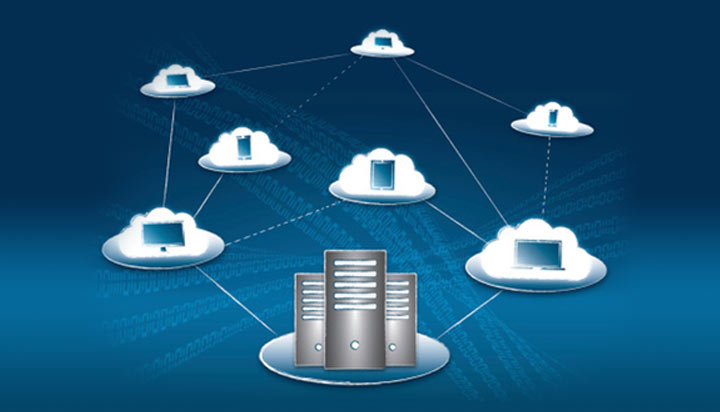
It is clear that the modern data center is software driven, and we can group it into 3 high-level units:
- IaaS or Infrastructure-as-a-service software that comes down to a hypervisor for operating system virtualization. As a rule, enterprise virtualization (IaaS) brings with it a number of tools for easier management, disaster recovery, high availability, software defined storage, etc.
- PaaS or enterprise containerization platform (Platform-as-a-service) which can be located on-premises in a private cloud or on one of the public clouds (Azure, AWS, GCS).
- Tools and middleware software to support developers and fast application delivery: this includes CI / CD server and IDE tools, a wide selection of web and application servers and developer platforms (from Java, via node.js to PHP and .Net Core) to advanced middleware services for data integration (messaging, BPM, API management, data caching, etc.).
When discussing virtualization, containerization or supporting applications, it’s clear all three have to “run” in a complex hybrid environment, regardless of whether it’s an organization’s own infrastructure (on-premise) or an external IaaS / PaaS service provider (public cloud). Due to the heterogeneity of the environment, open source software has emerged as a solution to this complexity, which otherwise exceeds the capabilities of individual companies or manufacturers, no matter how large.
However, organizations also need support with open source software, reassurance that the manufacturer will fix things when something stops working, and also support the latest hardware, offer security patches, simple documentation, support for upgrades – in short, everything that is by default with enterprise commercial software.
The leader in enterprise open source software is Red Hat (now part of IBM) and has kept that position for decades.
Let’s see how Red Hat’s portfolio maps into the 3 groups listed above.
Enterprise virtualization (IaaS)
 The virtualization product is Red Hat Virtualization (RHV). The basis of virtualization is the Linux OS with KVM hypervisor, which is the industry standard and probably the most used hypervisor. But what is important is that RHV offers complete feature parity with what Vmware Vsphere administrators are familiar with, and we do not only mean the management console objects and concepts, but also high availability (HA), snapshot management, live migration of guest machines, SSO integration with organizational directory and RBAC, self-service portal, automation and orchestration, disaster recovery (DR) and backup, SDN with VLAN tagging and vNIC profiles, integrated software-defined-storage. RHV offers all this with commercial support, an official list of supported / certified hardware and a significantly lower TCO than the competition.
The virtualization product is Red Hat Virtualization (RHV). The basis of virtualization is the Linux OS with KVM hypervisor, which is the industry standard and probably the most used hypervisor. But what is important is that RHV offers complete feature parity with what Vmware Vsphere administrators are familiar with, and we do not only mean the management console objects and concepts, but also high availability (HA), snapshot management, live migration of guest machines, SSO integration with organizational directory and RBAC, self-service portal, automation and orchestration, disaster recovery (DR) and backup, SDN with VLAN tagging and vNIC profiles, integrated software-defined-storage. RHV offers all this with commercial support, an official list of supported / certified hardware and a significantly lower TCO than the competition.
In addition, Red Hat is a leader in the field of enterprise containerization (Kubernetes), and RHV offers easy integration of virtualization and containers, which brings us to the next topic – Openshift container platform (PaaS).
Enterprise containerization (PaaS)
 Red Hat Openshift is a leading enterprise container platform for scalably launching cloud-native applications regardless of location or cloud. In addition to offering always commercially supported Kubernetes with the latest functionalities, Red Hat ensures that installation and deployment is as easy as possible. This includes full-stack automated deployment independently running Openshift on your laptop or public cloud. Of course, you can also use your favorite private IaaS such as Vsphere.
Red Hat Openshift is a leading enterprise container platform for scalably launching cloud-native applications regardless of location or cloud. In addition to offering always commercially supported Kubernetes with the latest functionalities, Red Hat ensures that installation and deployment is as easy as possible. This includes full-stack automated deployment independently running Openshift on your laptop or public cloud. Of course, you can also use your favorite private IaaS such as Vsphere.
Openshift offers the ability to build your own enterprise repository but with all security controls (vulnerability scans, etc.) to avoid infiltrating security vulnerabilities into base images and thereby compromise the security and manageability of the data center.
Also, Openshift is packaged to offer users complete flexibility in choosing Application Runtimes and frameworks, while providing commercial support:
- Java Spring, Quarkus, EAP, Jakarta EE, MicroProfile, Thorntail
- Jboss web server (Tomcat)
- Open Liberty
- Vert.x
- Node.js
- AMQ message broker (uz JMS 1.1 i 2.0)
- Data Grid in-memory caching
- and a wide range of 3rd party software curated and certified through the Red Hat QA: Red Hat Marketplace.
All this with very transparent pricing and bundling, lower memory footprint and higher deployment density through which it is easy to calculate significantly lower TCO than the competition (Vmware Tanzu).
Supporting software and tools
The system administrator of a virtualization or container platform undoubtedly gets full support to run a modern data center. But what about another group of platform users – the developers?
In addition to the previously mentioned Application Runtimes, Red Hat offers developers a range of middleware data integration software through its Red Hat Integration bundle: 3Scale API Management, Fuse data integration (Apache Camel, etc.), AMQ Broker, AMQ Streams (Kafka), AMQ InterConnect, SSO identity broker, etc.
The middleware portfolio is the broadest on the market and fully integrated with Openshift container platform, fully based on open source standards.
Of course, you’ll also find a complete developer IDE supporting cloud native development and integrated with OpenShift: CodeReady Workspaces.
Additional info:


